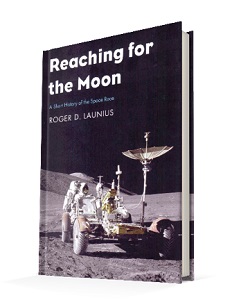It is a continual source of amazement that authors are still celebrating the ‘race to the Moon’ some five decades after the Apollo 11 mission successfully placed astronauts on the lunar surface. Clearly published as the former NASA chief historian’s contribution to that 50th anniversary, “Reaching for the Moon” is a brief and somewhat familiar reanalysis of the superpower space race.
The book is subtitled “A Short History of the Space Race” and it is certainly that. Indeed, one wonders whether the author had tongue firmly in cheek when he came up with the notion that any history of the subject could be covered in a little over 200 pages.
On the positive side, he magnanimously “places American and Soviet programs on equal footing” (according to the blurb) “to highlight key actions that led to various successes, failures, and ultimately the American Moon landing”. However, this is far from the first time an author has done so, and many European authors have produced much better texts on the subject.
The familiarity of the analysis is reinforced by the reuse of some widely published photographs: Korolev and his dog; a Soviet “engineer” with Sputnik; Explorer 1 held high by Pickering, Van Allen and von Braun; the Mercury 7; Earthrise; Aldrin and the flag… Worse still, they are poorly reproduced on that sepia-toned paper that American publishers seem to relish!
In his four-page concluding chapter, Launius states unnecessarily: “Any assessment of Apollo that does not recognize the accomplishment of landing Americans on the Moon and safely bringing them home before the end of the 1960s is incomplete and inaccurate, for that was the primary goal of the undertaking”. Phew, what a revelation! Isn’t that exactly what pretty much all the books on the Apollo programme have recognised? Wasn’t it, in fact, their very raison d’etre?
The back-cover endorsements from well-known space writers use words like “fascinating”, “important” and “must-read”, but I respectfully beg to differ. The emperor’s dress sense is not what it used to be!











